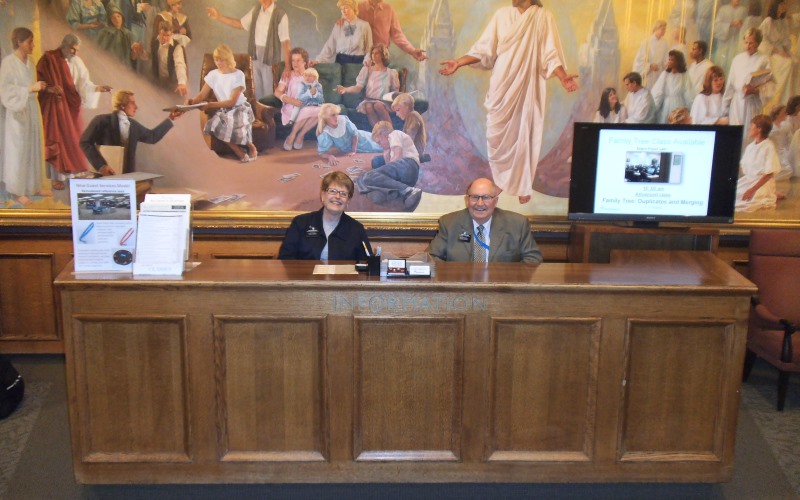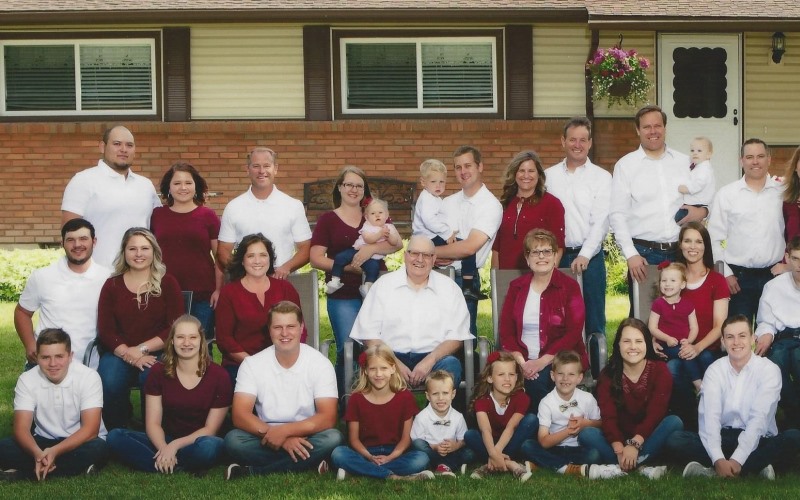|
BY [K1] KAREN BOSSICK Rosalie Kirkland can trace her lineage to the Mormon pioneers who came to Utah pulling handcarts. And she herself has served on the Navajo Reservation and in Nauvoo, Ill., telling others of early Mormon history. But she has made her mark on the community of Carey where she taught first grade and kindergarten for 20 years. For that she was named to the Blaine County Heritage Court, which honors women who have made a difference in the Wood River Valley.
|
|

Rosalie and Heber Kirkland helped people trace their family histories at the LDS genealogical library in Salt Lake City.
|
|
|
“I thought this was a teeny, tiny place when my husband brought me here to his family farm,” said Kirkland, who grew up in American Fork, Utah. “Once I got to know the people, I was impressed with how they were just salt-of-the-earth people.” Kirkland’s father’s mother emigrated from Scotland after her family was baptized into the Church of Jesus Christ of Latter-Day Saints. Traveling with the Willie company, they had to wait in Iowa City for handcarts to be built—handcarts that did not work well because the wood had not been seasoned. By the time they resumed their trip to the Promised Land, it was mid-July so they became stranded in blizzards while waiting for rescuers from Salt Lake City. “My great-grandfather kept a journal, and it breaks your heart to see what they had to deal with,” said Kirkland. “They ran out of food so he talked about boiling shoelaces from their boots to make shoelace soup. They thought it was wonderful because they had nothing else.”
|
|

Heber and Rosalie Kirkland are surrounded by family in this photo.
|
|
|
The missionaries who visited them in Scotland had given them a special blessing, promising them that all of their family would make it to Zion and none would be lost. Many died of hunger, exhaustion, illness and exposure as they crossed the Plains. And Kirkland’s family thought that one of their five children—12-year-old Elizabeth—had died, as well. They couldn’t bury her because the ground was frozen and her mother insisted that they had been promised by the Lord that all of the family would make it to Zion. As they splashed boiled water on the girl, her toes started to move, and the family realized the girl was alive. “She made it to American Fork where she became the mother of 13 children,” Kirkland said. “There’s a movie called “17 Miracles” that talked about the miracles that happened to the Willie and another handcart company and that’s one of them.”
Kirkland’s grandfather on her father’s side was from Denmark and they settled in nearby Pleasantville. “My mother’s family came across the Plains and helped settle Provo,” she added. “Her family came from England and they were in the first handcart company. “ Kirkland graduated from Brigham Young University in 1965 with a degree in elementary education. Her first job was teaching first grade in the same school room where she had started school. She met her husband-to-be Heber Kirkland at Brigham Young University and the two were married in the Sale Lake temple. He’d been born and raised in Carey on the farm his father’s family had come from Florida to homestead in the early 1900s at the encouragement of a missionary. Heber had stepped up to help with the family farm at 15 after his father died.
The couple moved to Twin Falls after marrying, with Heber teaching at the high school and coaching track and Rosalie teaching at the elementary school. In 1972 they moved to Carey to live on the family farm where they raised four children. When the youngest son entered kindergarten, Kirkland agreed to teach kindergarten for 10 years; she later swapped classes with the first-grade teacher and taught for 10 more years. “When I retired in 2001, my oldest granddaughter was in my class,” she said. “My husband was the social studies teacher and basketball and football coach for 19 years. He took the boys to two state championships, but winning wasn’t the important thing. He was very concerned about teaching the boys to do their best, to be good and respectful. And I had high expectations for my students, as well.” Upon retirement, the Kirklands were called by the church to help prepare young Navajo children for school at Window Rock, Ariz., on the Navajo Nation. Considered the Washington, D.C., of the Navajo people, the area was named for a red sandstone arch that boasted a window. A monument dedicated to the Navajo code talkers sits at its base.
“At first it was a little scary, but as we got to know the people it was wonderful,” she said. We taught chapel at the St. Michael’s Indian School in an early bird program started by a Catholic nun. We’d go into the homes and get to know the children and their families. We’d play games with the kids, and we gleaned outdated produce from the supermarket to give to the families.” Kirkland paused: “A lot of those who lived there had gone to boarding schools where they suffered abuse. A lot of men took to drink while women took care of things. They suffered a lot and they had a terrible time with COVID, but they were very sweet. Even now we keep in touch. And they’re modernizing so they’re beginning to get good jobs.” After Window Rock, the Kirklands were assigned to the living historic district of Nauvoo, Ill., where they dressed in 19th century costumes and demonstrated what it was like to work in a blacksmith shop, make Nauvoo bricks, knit a rug and make boots. “I liked serving in the Brigham Young home because he had such a fascinating story. And the Wilford Woodruff home, too,” she said.
Following Nauvoo, the couple helped people trace their family lineage in Salt Lake City’s Family History Library—the largest genealogical library in the world. They then returned to Idaho where they spent eight years as ordinance workers in the Twin Falls temple. Today, they live on the family farm in Carey. Son Lane teaches at Carey School and manages the farm, which includes 100 acres of hay and a few cattle and sheep. And Rosalie and Heber spend time playing with the grandchildren and great-grandchildren, while gardening and putting up preserves. In the past 10 years they’ve seen their town double in size—from 651 in 2010 to 1,265, according to the last census count. “When I came here it was a beautiful little community but very small,” Kirkland said. “Of course, it’s huge now.”
|